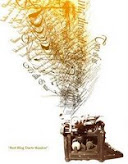Charles Wilson Peale was born in Maryland in 1741. When he was thirteen, he became an apprentice—but not to an artist. Peale learned how to make horse saddles. He then taught himself to silversmith, paint signs, and upholster furniture. Peale was interested in a lot of things, as you can see.
He went to London in 1767 to study painting. When he returned to America (the colonies) two years later, he painted the first portrait of George Washington (shown below). Peale painted almost 60 portraits of Washington over the course of his life.
 Peale went to Philadelphia in 1776, a date you know as the year the colonies declared their independence from Brittan. In Philadelphia, Peale painted portraits of many members of the young American government.
Peale went to Philadelphia in 1776, a date you know as the year the colonies declared their independence from Brittan. In Philadelphia, Peale painted portraits of many members of the young American government.In 1777, Peale joined the Continental Army. During his service, he captured the officers’ portraits in miniature paintings which he later copied onto larger canvases. Shown below is a portrait of Arthur St. Clair that was painted during this time. St. Clair tried to defend Fort Ticonderoga but was forced to retreat. Later, St. Clair was with George Washington when the British surrendered at Yorktown, the last major battle of the Revolutionary War.
 Throughout his life, Peale painted portraits of many of the most influential people in the making of America. Below are some of Peale’s portraits.
Throughout his life, Peale painted portraits of many of the most influential people in the making of America. Below are some of Peale’s portraits. John Adams who served as the 2nd president of the U.S.:
 Thomas Jefferson who wrote the declaration of independence and served as the 3rd president of the U.S:
Thomas Jefferson who wrote the declaration of independence and served as the 3rd president of the U.S: 
Meriwether Lewis (left) and William Clark (right) who explored the west:


Tomorrow, I’ll tell you about Charles Wilson Peale’s love for science.
Edited to Add: Ms. Julie has an art lesson posted at her site which uses Peale's portraits to teach about the Lewis and Clark expedition. Go check it out!
Return to main page.








4 comments:
Incredible how productive he must have been! Also, you have the feeling that he has made very true portraits, so nice to have, from before the times when the photos took over this role and allowed (or forced?) painters to be more "creative".
I did an art lesson with the Peale portraits of Lewis and Clark last year for a 5th through 8th grade class. We did a guided drawing lesson recreating these two and a Sacajawea thrown in too. I don't think the kids will soon forget all they learned about the expedition since drawing things you are learning about help to cement them in the memory. You can check out the story and the sample I made over here
http://msjuliesartschool.blogspot.com/2008/05/great-result.html
Peter,
It's even more incredible when you think about all the other things he was doing. He went on a scientific expedition, created his own natural history museum, invented at least a half a dozen things... and painted.
Peale did make realistic paintings. I like that about him. There are a lot of portraits that show what the subject wished he or she looked like instead of what s/he actually looked like. But I'm glad we have photos now. They are much more reliable!
Ms. Julie,
You are absolutely right. When kids draw what they are learning about, they are forced to pay attention to the details. That sounds like a memorable lesson.
When I was in elementary school we made paper mache puppets of the founders and put on a historical play. I don't remember the play but I do remember making those puppets!
I'm going to add a link to your site in the main body of the post. Thanks for the link!
Post a Comment